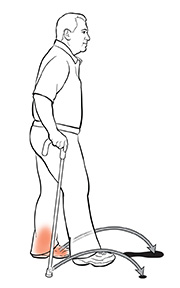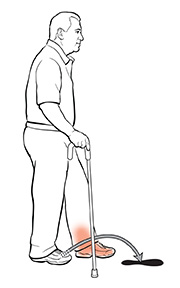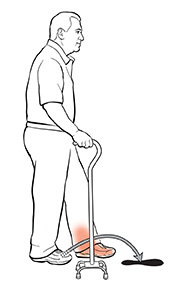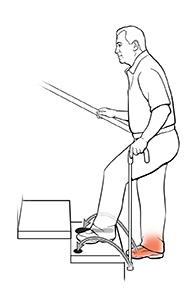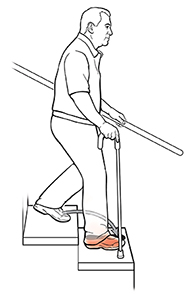A cane helps you get around on your own. Many different canes are available. The most common type has a single tip. But if you have balance problems, your health care provider may recommend that you use a quad (four-point) cane. Always use your cane on the stronger (uninjured or unaffected) side unless you are told otherwise. Use the cane on the side opposite your affected leg, and move the cane and affected leg together.
Adjust the height of your cane so that the handle is at your hip level and your elbow bends slightly while holding it. The top or curve of the cane should hit the bend in your wrist.
Walking
1.
-
Put all your weight on your stronger leg.
-
Find your balance.
-
Move the cane and your weaker leg forward.
-
Place your cane firmly on the ground before you take a step.
-
Do not place your cane too far ahead of you or it could slip forward.
2.
-
Support your weight on both the cane and the affected leg.
-
Then step through with your stronger leg.
-
Put your weight on the affected leg and the cane, and start the next step.
-
When using a quad cane, place the cane so that all of the tips touch the ground.
Up stairs and curbs
-
If there is a railing, hold on to it with your free hand.
-
Step up with your stronger leg first.
-
Then move the cane and weaker leg together as a unit.
-
When you reach the top, stop for a moment to regain your balance and strength before moving on.
Down stairs and curbs
-
To walk down, step down with your weaker leg and the cane first.
-
Then follow with your stronger leg.
Safety tips
-
Always look out for wet and slippery surfaces. Water, ice, and snow make walking surfaces wet.
-
Make sure your surroundings are free of clutter.
-
-
Remove slippery rugs.
-
Secure cords and rug corners to the floor.
-
Arrange your furniture so that you have clear, wide pathways between rooms.
-
Keep stairs clear of packages, boxes, or clutter. If needed, add non-slip treads to stairs to prevent slipping.
-
-
Wear supportive shoes that have nonslip rubber soles. Don't wear shoes with heels or leather soles.
-
Regularly check the condition of your cane's rubber tip. Replace the tip right away if it is worn down.
-
Use a small backpack, fanny pack, or shoulder bag to hold items that you need with you (such as your phone). This will keep your hands free while you are walking.
Featured in
